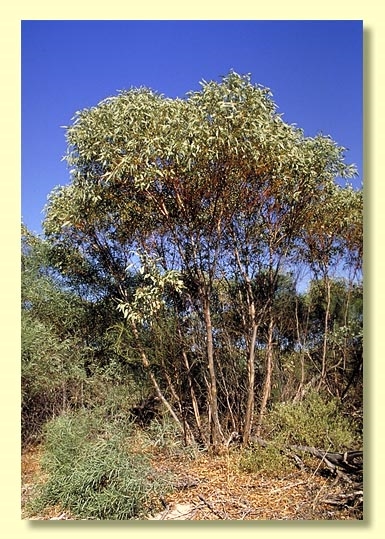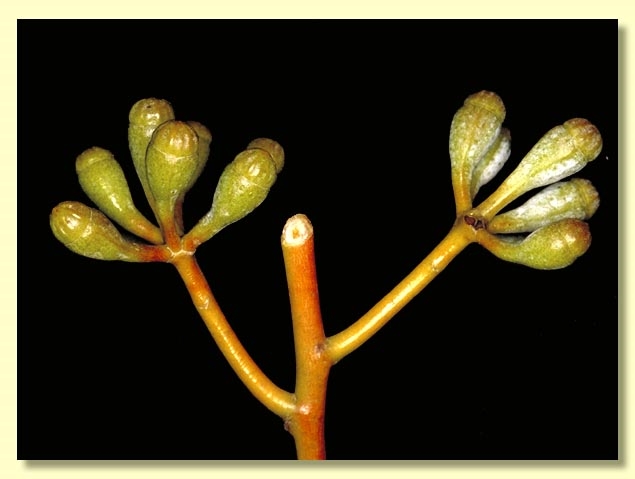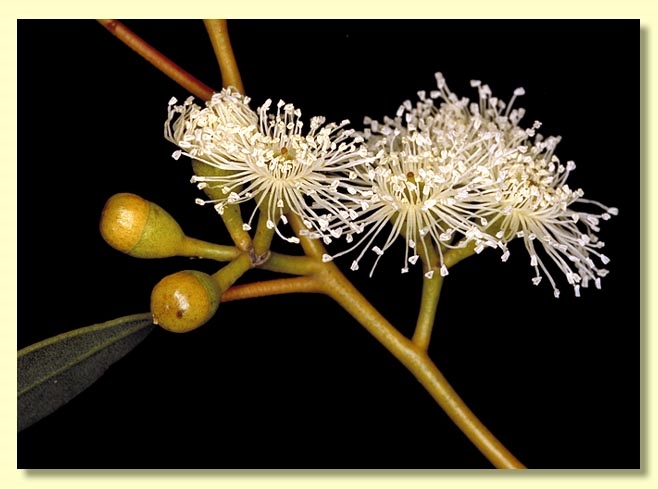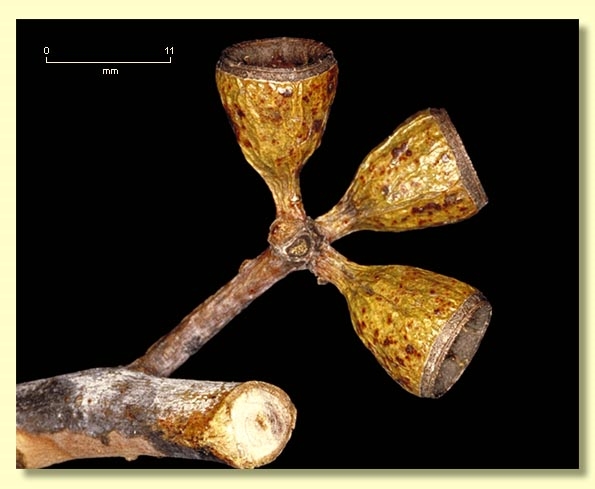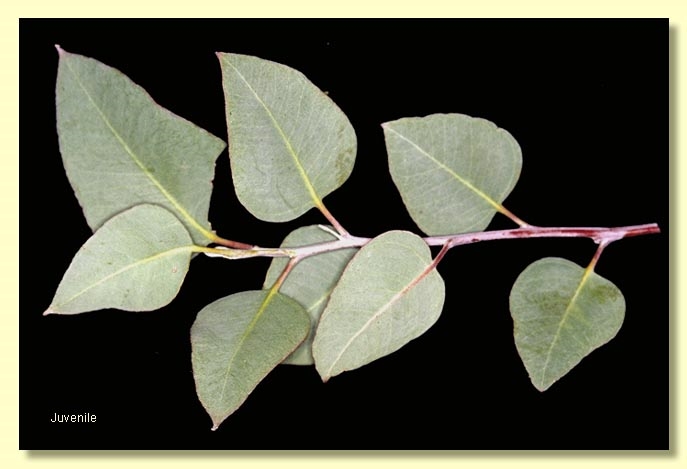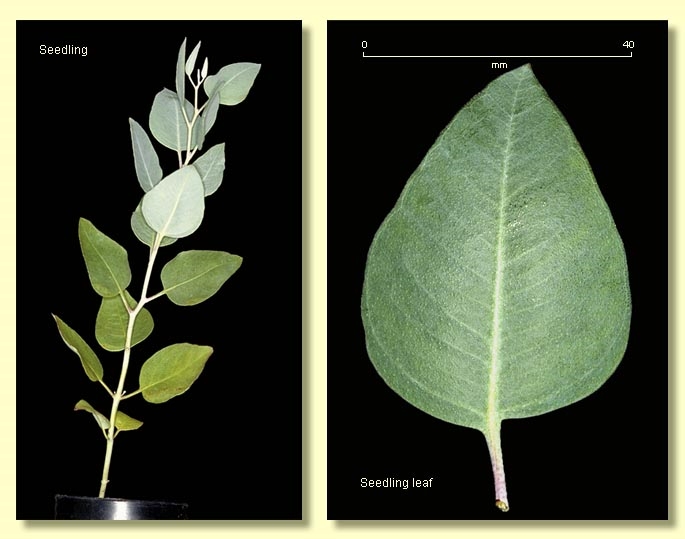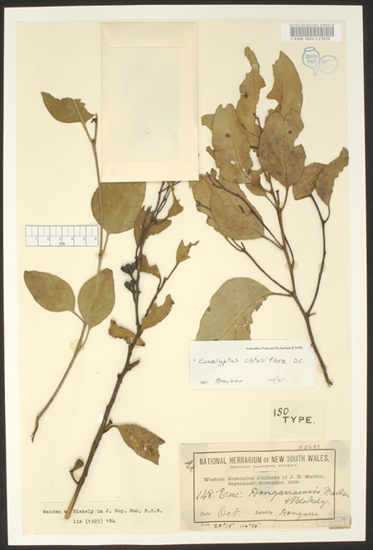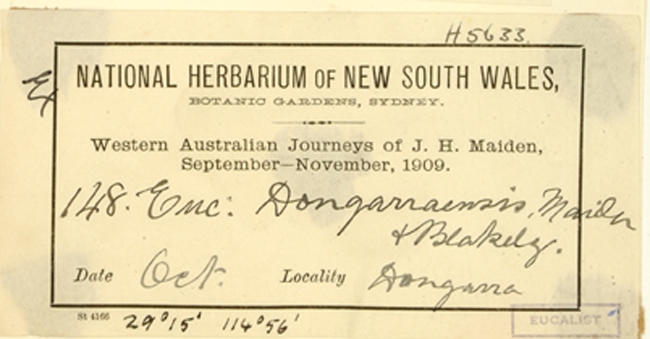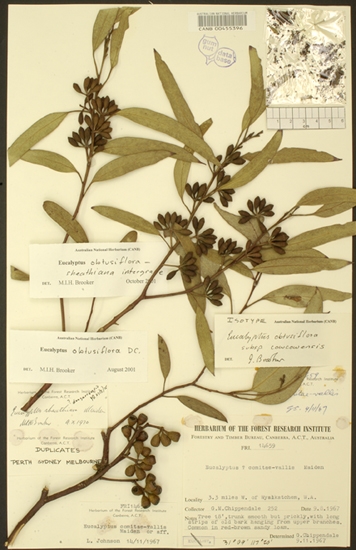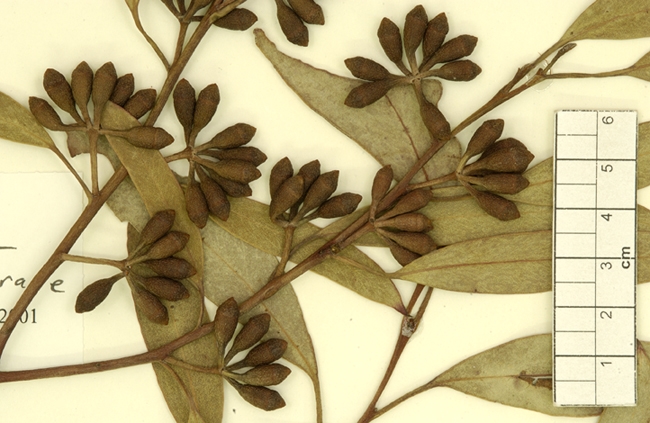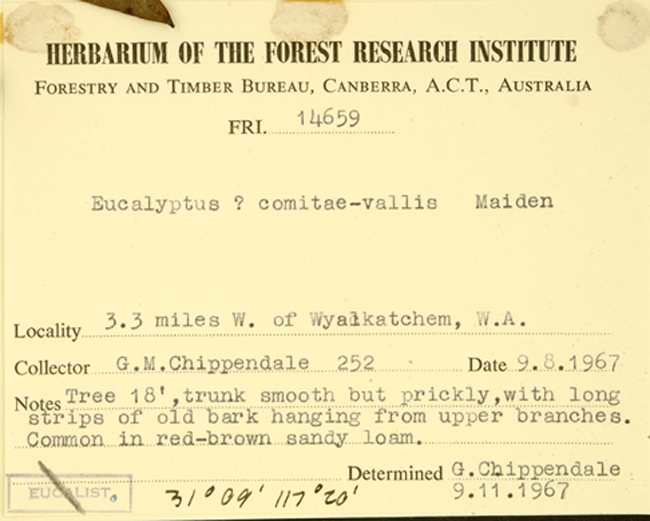Euclid - Online edition
Eucalyptus obtusiflora
Eucalyptus | Symphyomyrtus | Dumaria | Rufispermae
Eucalyptus obtusiflora DC., Prodr. 3: 220 (1828).
T: Nouvelle Hollande, côte orient.; mus. de Par.: 1821 holo: G-DC G00657440; (fide Nicolle, D., George, A. & Weston, P.G. Telopea 22: 61-66 (2019); this paper formally clarified the existing typification confusion and mistakes, agreeing with Hill & Johnson (2001) that the Sieber 473 specimens previously asserted to be types had become mixed and that only one, that matching an illustration in de Candolle (1842) Mémoire sur la famille des Myrtacées, could be the type, viz. that specimen held in Prodromus herbarium: G-DC G00657440; there is also doubt as to who collected the holotype as Sieber did not visit Western Australia)).
Eucalyptus virgata var. obtusiflora (DC.) Maiden, The Forest Flora of New South Wales 3 (June 1907) 85. T: 'in Nova-Hollandia ad oram orientation', 1823, F. W. Sieber 473; type: G-DC. For some information about the confusion surrounding the typification of this species the reader is directed to K.D.Hill et al, Telopea 9: 302 (2001), but see note below also.
Eucalyptus obtusifolia G.Don, A General History of Dichlamydeous Plants 2:820 (1832). T: ?
Eucalyptus dongarraensis Maiden & Blakely, J. & Proc. Roy. Soc. New South Wales 59: 184 (1925). T: Western Australia: Dongarra, J.H. Maiden, Oct 1909 (holo NSW; iso CANB, K, MEL, PERTH—2 sheets).
[note added by A.V. Slee 10 May 2015: in JSTOR the images of the following specimens of Sieber 473 held in European herbaria, with specimen numbers BM001015256, BR0000005236503, HAL0089649, G00227744 are each images of specimens of a species in Eucalyptus subgenus Eucalyptus (not subgenus Symphyomyrtus), as the anthers are kidney-shaped with confluent lines of dehiscence. Thus they cannot be the type of the species Eucalyptus obtusiflora as stated in earlier editions of EUCLID (and in general usage at that time). Hill et al (ibid.) assert that a Geneva (G-DC) specimen is the type).
see http://plants.jstor.org/search?searchText=Sieber+473&st=6435&t=2076]
Usually a mallee to 4 m tall, less commonly a small tree to 12 m tall. Forming a lignotuber.
Bark rough, imperfectly shed grey to brown, ribbony for up to half of the stems then smooth above, or smooth-barked throughout, grey over yellowish or salmon pink to creamy brown.
Branchlets not glaucous; dark brownoil glands present in the pith.
Juvenile growth (coppice or field seedlings to 50 cm): stems square to round in cross-section, glaucous or non-glaucous, sparsely warty or not; juvenile leaves always petiolate, opposite at lowest node then alternate, lowest leaves deltoid but soon ovate, 4–8 cm long, (1.7)2.5–5 cm wide, base truncate or rounded to tapering, grey-green, sometimes glaucous.
Adult leaves alternate, petioles 1.2–2.5(3.2) cm long; blade lanceolate or falcate, (6)7–13(16.2) cm long, (0.8)1–2.5(3) cm wide, base tapering, margin entire, apex pointed, dull, bluish green to green, concolorous, side-veins at an acute angle to midrib (to ca 40°), reticulation dense to very dense, intramarginal vein present, oil glands intersectional.
Inflorescence axillary unbranched, peduncles (0.3)0.5–2 cm long, angular, buds 7 or 9, rarely 11, per umbel, non-glaucous, less commonly glaucous, pedicellate, pedicels (0.1)0.2–1.0 cm long. Mature buds ovoid to obovoid to cylindrical or narrowly pyriform, (0.7–1.2 cm long, 0.5–0.8 cm wide), scar present (outer operculum shed very early), inner operculum rounded to flattened, or umbonate/weakly beaked when immature, slightly contracted at join with hypanthium or not (0.2–0.3 cm long), weakly radially striate, stamens regularly inflexed, anthers cuboid to wedge-shaped, versatile, sub-dorsifixed, dehiscing by longitudinal slits, style long and straight, stigma bluntly conic, locules 4 or 5, the placentae each with 4 vertical rows of ovules. Flowers creamy white.
Fruit pedicellate, pedicels (0.1)0.3–1.0 cm long, usually cupular-obconical to barrel-shaped but tapering basally, (0.6)0.7–1.2 cm long, (0.6)0.7–1 cm wide, occasionally glaucous but more usually not so, disc descending vertically, valves 4 or 5, rim level.
Seeds reddish brown, glossy, 1–3.5 mm long, flattened-ovoid to angular, dorsal surface shallowly lacunose and weakly reticulate, hilum ventral.
Cultivated seedlings (measured at ca node 10): cotyledons reniform; stems square in cross-section or sometimes rounded, glaucous or not, warty or not; leaves always petiolate, opposite for ca 3–6 nodes then alternate, ovate or rarely deltoid, 3.3–6.7 cm long, 1.5–4.5 cm wide, base rounded to tapering, apex more or less pointed, grey-green or blue-green, sometimes with waxy bloom especially on newly expanding leaves.
Flowering has been recorded in January, February, March, May, September and November.
A mallee or small tree endemic to Western Australia, widespread north of Perth from Jurien and Moora towards Shark Bay (including Dorre and Bernier Islands) and north to Gnaraloo, extending inland as far as Wannoo, Ajana, Wubin, Wyalkatchem and Corrigin. The bark is entirely smooth or the trunks are clothed with imperfectly shed ribbons of rough bark on the lower half. Adult leaves are dull light green or grey-green and buds ovoid-cylindrical with an obtuse operculum.
In the classification of Brooker (2000) Eucalyptus obtusiflora belongs in Eucalyptus subgenus Symphyomyrtus section Dumaria having these features: buds initially with two opercula the outer shed early, stamens strongly inflexed, ovules in 4 rows on the placentae and cotyledons reniform. Within section Dumaria the species belongs to a large sub-group of closely related species (series Rufispermae, 37 described species and subspecies) diagnosed by glandular pith in the branchlets, anthers cuboid to wedge-shaped, versatile, and by the reddish brown and glossy, flattish seeds which are unique to the series.
Within series Rufispermae, E. obtusiflora is most closely related to E. sheathiana, a smooth-barked and usually glaucous mallee or lignotuberous tree very widespread from Wongan Hills south-east through the wheatbelt to about Hyden. The two species grade into one another morphologically and plants may by unidentifiable in the Wongan Hills area. E. obtusiflora usually has thicker leaves and flattened to rounded opercula whilst E. sheathiana has distinctly conical opercula. In sub-coastal areas to the south of the distribution of E. obtusiflora a completely non-glaucous species, E. argutifolia, also in series Rufispermae, occurs in the Wabling Hill and Parrot Ridge area. E. argutifolia has broad glossy green adult leaves
E. obtusiflora has been split (Hill et al, 2001) with the description of two new taxa, E. wubinensis and E. obtusiflora subsp. cowcowensis, and the reinstatement of a third, E. obtusiflora subsp. dongarraensis. E. obtusiflora subsp. dongarraensis and subsp. cowcowensis show only minor differences from subsp. obtusiflora in pedicel length and in the amount of visible wax (glaucescence), both characters being quite variable in the field. Many plants seem intermediate between these subspecies.
Eucalyptus wubinensis is a non-glaucous mallee species differing from E. obtusiflora in having smaller buds and fruit, and occurs in the central wheatbelt between Wubin and Ballidu extending east to near southern Lake Moore, Wialki and Mukinbudin. E. wubinensis is a smooth-barked mallee with non-glaucous adult parts, fruit only to 0.5–0.7 cm diameter, and, fide Hill et al (2001), glaucous juvenile growth. In comparison E. obtusiflora (all subspecies) have fruit 0.7–1.2 cm diameter and, fide specimens in CANB, juvenile growth green, grey-green or glaucous.
Because the segregation into subspecies is weak the subspecies are not included in the interactive key. They are however diagnosed below for those wishing to try to assign specimens of E. obtusiflora to subspecific rank:
subsp. obtusiflora
A widespread non-glaucous subspecies, usually a mallee with some rough bark on lower half of trunks, buds more cylindrical-ovoid with rounded-flattened opercula, pedicels (0.1)0.2–1.0 cm long. Plants in the north of the subspecies geographic range have longer peduncles and pedicels and often slightly larger fruit than further south. It occurs from Gnaraloo and Shark Bay area south and inland from Wannoo to Wubin and near Wongan Hills
subsp. cowcowensis
Restricted to the south of the species range occurring sporadically from Lake Cowcowing south to Corrigin, it has a more erect small tree or tall mallee habit, completely smooth bark, buds tapering basally rather than cylindrical with rounded to slightly conical operculum, and pedicels 0.4–0.8 cm long. Plants are non-glaucous except for juvenile growth. Trees from the Merredin and Kellerberrin area match this subspecies except for having glaucous buds, fruit and branchlets, and may be intermediate in character between this and E. sheathiana.
subsp. dongarraensis
This smooth-barked mallee subspecies is coastal in distribution from about Dongara south to Jurien, frequently has glaucous branchlets and buds, and with the buds more or less cylindrical-ovoid with rounded-flattened opercula and pedicels (0.1)0.2–0.5 cm long.

